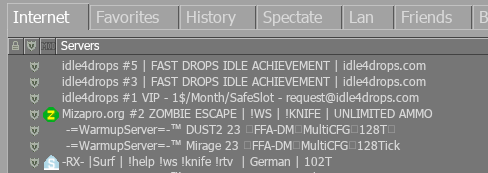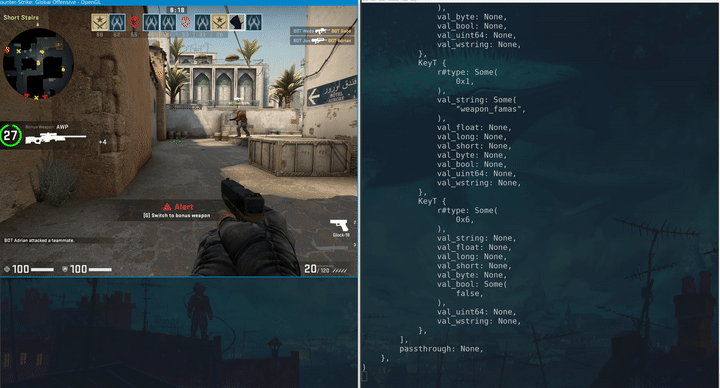One of the factors contributing to Counter-Strike Global Offensive’s (herein “CS:GO”) massive popularity is the ability for anyone to host their own community server. These community servers are free to download and install and allow for a high grade of customization. Server administrators can create and utilize custom assets such as maps, allowing for innovative game modes.
However, this design choice opens up a large attack surface. Players can connect to potentially malicious servers, exchanging complex game messages and binary assets such as textures.
We’ve managed to find and exploit two bugs that, when combined, lead to reliable remote code execution on a player’s machine when connecting to our malicious server. The first bug is an information leak that enabled us to break ASLR in the client’s game process. The second bug is an out-of-bounds access of a global array in the .data section of one of the game’s loaded modules, leading to control over the instruction pointer.
Community server list
Players can join community servers using a user friendly server browser built into the game:

Once the player joins a server, their game client and the community server start talking to each other. As security researchers, it was our task to understand the network protocol used by CS:GO and what kind of messages are sent so that we could look for vulnerabilities.
As it turned out, CS:GO uses its own UDP-based protocol to serialize, compress, fragment, and encrypt data sent between clients and a server. We won’t go into detail about the networking code, as it is irrelevant to the bugs we will present.
More importantly, this custom UDP-based protocol carries Protobuf serialized payloads. Protobuf is a technology developed by Google which allows defining messages and provides an API for serializing and deserializing those messages.
Here is an example of a protobuf message defined and used by the CS:GO developers:
message CSVCMsg_VoiceInit {
optional int32 quality = 1;
optional string codec = 2;
optional int32 version = 3 [default = 0];
}
We found this message definition by doing a Google search after having discovered CS:GO utilizes Protobuf. We came across the SteamDatabase GitHub repository containing a list of Protobuf message definitions.
As the name of the message suggests, it’s used to initialize some kind of voice-message transfer of one player to the server. The message body carries some parameters, such as the codec and version used to interpret the voice data.
Developing a CS:GO proxy
Having this list of messages and their definitions enabled us to gain insights into what kind of data is sent between the client and server. However, we still had no idea in which order messages would be sent and what kind of values were expected. For example, we knew that a message exists to initialize a voice message with some codec, but we had no idea which codecs are supported by CS:GO.
For this reason, we developed a proxy for CS:GO that allowed us to view the communication in real-time. The idea was that we could launch the CS:GO game and connect to any server through the proxy and then dump any messages received by the client and sent to the server. For this, we reverse-engineered the networking code to decrypt and unpack the messages.
We also added the ability to modify the values of any message that would be sent/received. Since an attacker ultimately controls any value in a Protobuf serialized message sent between clients and the server, it becomes a possible attack surface. We could find bugs in the code responsible for initializing a connection without reverse-engineering it by mutating interesting fields in messages.
The following GIF shows how messages are being sent by the game and dumped by the proxy in real-time, corresponding to events such as shooting, changing weapons, or moving:

Equipped with this tooling, it was now time for us to discover bugs by flipping some bits in the protobuf messages.
OOB access in CSVCMsg_SplitScreen
We discovered that a field in the CSVCMsg_SplitScreen message, that can be sent by a (malicious) server to a client, can lead to an OOB access which subsequently leads to a controlled virtual function call.
The definition of this message is:
message CSVCMsg_SplitScreen {
optional .ESplitScreenMessageType type = 1 [default = MSG_SPLITSCREEN_ADDUSER];
optional int32 slot = 2;
optional int32 player_index = 3;
}
CSVCMsg_SplitScreen seemed interesting, as a field called player_index is controlled by the server. However, contrary to intuition, the player_index field is not used to access an array, the slot field is. As it turns out, the slot field is used as an index for the array of splitscreen player objects located in the .data segment of engine.dll file without any bounds checks.
Looking at the crash we could already observe some interesting facts:
- The array is stored in the
.datasection withinengine.dll - After accessing the array, an indirect function call on the accessed object occurs
The following screenshot of decompiled code shows how player_splot was used without any checks as an index. If the first byte of the object was not 1, a branch is entered:

The bug proved to be quite promising, as a few instructions into the branch a vtable is dereferenced and a function pointer is called. This is shown in the next screenshot:

We were very excited about the bug as it seemed highly exploitable, given an info leak. Since the pointer to an object is obtained from a global array within engine.dll, which at the time of writing is a 6MB binary, we were confident that we could find a pointer to data we control. Pointing the aforementioned object to attacker controlled data would yield arbitrary code execution.
However, we would still have to fake a vtable at a known location and then point the function pointer to something useful. Due to this constraint, we decided to look for another bug that could lead to an info leak.
Uninitialized memory in HTTP downloads leads to information disclosure
As mentioned earlier, server admins can create servers with any number of customizations, including custom maps and sounds. Whenever a player joins a server with such customizations, files behind the customizations need to be transferred. Server admins can create a list of files that need to be downloaded for each map in the server’s playlist.
During the connection phase, the server sends the client the URL of a HTTP server where necessary files should be downloaded from. For each custom file, a cURL request would be created. Two options that were set for each request piqued our interested: CURLOPT_HEADERFUNCTION and CURLOPT_WRITEFUNCTION. The former allows a callback to be registered that is called for each HTTP header in the HTTP response. The latter allows registering a callback that is triggered whenever body data is received.
The following screenshot shows how these options are set:

We were interested in seeing how Valve developers handled incoming HTTP headers and reverse engineered the function we named CurlHeaderCallback().
It turned out that the CurlHeaderCallback() simply parsed the Content-Length HTTP header and allocated an uninitialized buffer on the heap accordingly, as the Content-Length should correspond to the size of the file that should be downloaded.
The CurlWriteCallback() would then simply write received data to this buffer.
Finally, once the HTTP request finished and no more data was to be received, the buffer would be written to disk.
We immediately noticed a flaw in the parsing of the HTTP header Content-Length: As the following screenshot shows, a case sensitive compare was made.

Case sensitive search for the Content-Length header.
This compare is flawed as HTTP headers can be lowercase as well. This is only the case for Linux clients as they use cURL and then do the compare. On Windows the client just assumes that the value returned by the Windows API is correct. This yields the same bug, as we can just send an arbitrary Content-Length header with a small response body.
We set up a HTTP server with a Python script and played around with some HTTP header values. Finally, we came up with a HTTP response that triggers the bug:
HTTP/1.1 200 OK
Content-Type: text/plain
Content-Length: 1337
content-length: 0
Connection: closed
When a client receives such a HTTP response for a file download, it would recognize the first Content-Length header and allocate a buffer of size 1337. However, a second content-length header with size 0 follows. Although the CS:GO code misses the second Content-Length header due to its case sensitive search and still expects 1337 bytes of body data, cURL uses the last header and finishes the request immediately.
On Windows, the API just returns the first header value even though the response is ill-formed. The CS:GO code then writes the allocated buffer to disk, along with all uninitialized memory contents, including pointers, contained within the buffer.
Although it appears that CS:GO uses the Windows API to handle the HTTP downloads on Windows, the exact same HTTP response worked and allowed us to create files of arbitrary size containing uninitialized memory contents on a player’s machine.
A server can then request these files through the CNETMsg_File message. When a client receives this message, they will upload the requested file to the server. It is defined as follows:
message CNETMsg_File {
optional int32 transfer_id = 1;
optional string file_name = 2;
optional bool is_replay_demo_file = 3;
optional bool deny = 4;
}
Once the file is uploaded, an attacker controlled server could search the file’s contents to find pointers into engine.dll or heap pointers to break ASLR. We described this step in detail in our appendix section Breaking ASLR.
Putting it all together: ConVars as a gadget
To further enable customization of the game, the server and client exchange ConVars, which are essentially configuration options.
Each ConVar is managed by a global object, stored in engine.dll. The following code snippet shows a simplified definition of such an object which is used to explain why ConVars turned out to be a powerful gadget to help exploit the OOB access:
struct ConVar {
char *convar_name;
int data_len;
void *convar_data;
int color_value;
};
A community server can update its ConVar values during a match and notify the client by sending the CNETMsg_SetConVar message:
message CMsg_CVars {
message CVar {
optional string name = 1;
optional string value = 2;
optional uint32 dictionary_name = 3;
}
repeated .CMsg_CVars.CVar cvars = 1;
}
message CNETMsg_SetConVar {
optional .CMsg_CVars convars = 1;
}
These messages consist of a simple key/value structure. When comparing the message definition to the struct ConVar definition, it is correct to assume that the entirely attacker-controllable value field of the ConVar message is copied to the client’s heap and a pointer to it is stored in the convar_value field of a ConVar object.
As we previously discussed, the OOB access in CSVCMsg_SplitScreen occurs in an array of pointers to objects. Here is the decompilation of the code in which the OOB access occurs as a reminder:

Since the array and all ConVars are located in the .data section of engine.dll, we can reliably set the player_slot argument such that the ptr_to_object points to a ConVar value which we previously set. This can be illustrated as follows:
We also mentioned earlier that a few instructions after the OOB access a virtual method on the object is called. This happens as usual through a vtable dereference. Here is the code again as a reminder:

Since we control the contents of the object through the ConVar, we can simply set the vtable pointer to any value. In order to make the exploit 100% reliable, it would make sense to use the info leak to point back into the .data section of engine.dll into controlled data.
Luckily, some ConVars are interpreted as color values and expect a 4 byte (Red Blue Green Alpha) value, which can be attacker controlled. This value is stored directly in the color_value field in above struct ConVar definition. Since the CS:GO process on Windows is 32-bit, we were able to use the color value of a ConVar to fake a pointer.
If we use the fake object’s vtable pointer to point into the .data section of engine.dll, such that the called method overlaps with the color_value, we can finally hijack the EIP register and redirect control flow arbitrarily. This chain of dereferences can be illustrated as follows:
ROP chain to RCE
With ASLR broken and us having gained arbitrary instruction pointer control, all that was left to do was build a ROP chain that finally lead to us calling ShellExecuteA to execute arbitrary system commands.
Conclusion
We submitted both bugs in one report to Valve’s HackerOne program, along with the exploit we developed that proved 100% reliablity. Unfortunately, in over 4 months, we did not even receive an acknowledgment by a Valve representative. After public pressure, when it became apparent that Valve had also ignored other Security Researchers with similar impact, Valve finally fixed numerous security issues. We hope that Valve re-structures its Bug Bounty program to attract Security Researchers again.
Time Table
| Date (DD/MM/YYYY) | What |
|---|---|
| 04.01.2021 | Reported both bugs in one report to Valve’s bug bounty program |
| 11.01.2021 | A HackerOne triager verifies the bug and triages it |
| 10.02.2021 | First follow-up, no response from Valve |
| 23.02.2021 | Second follow-Up, no response from Valve |
| 10.04.2021 | Disclosure of Bug existance via twitter |
| 15.04.2021 | Third follow-up, no response from Valve |
| 28.04.2021 | Valve patches both bugs |
Breaking ASLR
In the Uninitialized memory in HTTP downloads leads to information disclosure section, we showed how the HTTP download allowed us to view arbitrarily sized chunks of uninitialized memory in a client’s game process.
We discovered another message that seemed quite interesting to us: CSVCMsg_SendTable. Whenever a client received such a message, it would allocate an object with attacker-controlled integer on the heap. Most importantly, the first 4 bytes of the object would contain a vtable pointer into engine.dll.
def spray_send_table(s, addr, nprops):
table = nmsg.CSVCMsg_SendTable()
table.is_end = False
table.net_table_name = "abctable"
table.needs_decoder = False
for _ in range(nprops):
prop = table.props.add()
prop.type = 0x1337ee00
prop.var_name = "abc"
prop.flags = 0
prop.priority = 0
prop.dt_name = "whatever"
prop.num_elements = 0
prop.low_value = 0.0
prop.high_value = 0.0
prop.num_bits = 0x00ff00ff
tosend = prepare_payload(table, 9)
s.sendto(tosend, addr)
The Windows heap is kind of nondeteministic. That is, a malloc -> free -> malloc combo will not yield the same block. Thankfully, Saar Amaar published his great research about the Windows heap, which we consulted to get a better understanding about our exploit context.
We came up with a spray to allocate many arrays of SendTable objects with markers to scan for when we uploaded the files back to the server. Because we can choose the size of the array, we chose a not so commonly alloacted size to avoid interference with normal game code. If we now deallocate all of the sprayed arrays at once and then let the client download the files the chance of one of the files to hit a previously sprayed chunk is relativly high.
In practice, we almost always got the leak in the first file and when we didn’t we could simply reset the connection and try again, as we have not corrupted the program state yet. In order to maximize success, we created four files for the exploit. This ensures that at least one of them succeeds and otherwise simply try again.
The following code shows how we scanned the received memory for our sprayed object to find the SendTable vtable which will point into engine.dll.
files_received.append(fn)
pp = packetparser.PacketParser(leak_callback)
for i in range(len(data) - 0x54):
vtable_ptr = struct.unpack('<I', data[i:i+4])[0]
table_type = struct.unpack('<I', data[i+8:i+12])[0]
table_nbits = struct.unpack('<I', data[i+12:i+16])[0]
if table_type == 0x1337ee00 and table_nbits == 0x00ff00ff:
engine_base = vtable_ptr - OFFSET_VTABLE
print(f"vtable_ptr={hex(vtable_ptr)}")
break
